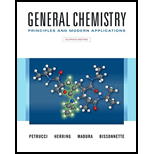
(a)
Interpretation:
The maximum number of moles of ATP that could form from ADP and phosphate if all the energy of combustion of 1 mol of glucose could be utilized should be calculated.
Concept introduction:
The major source of energy in animals is glucose. The energy released by the combustion of glucose is consumed to produce ATP.
In cells this reaction is coupled to the synthesis of ATP from ADP and phosphate.
ATP synthesis reaction,
(b)
Interpretation:
Efficiency of energy conversion of the cell should be calculated.
Concept introduction:
Energy released by the combustion of glucose is not completely goes into the production of ATP. Only a fraction of energy is participating. Some energy is lost as heat.
(c)
Interpretation:
ΔrG0 for the conversion of 1 mol ADP to ATP and ΔrG0 for oxidation of 1 mol of glucose under the given conditions should be calculated.
Concept introduction:
(d)
Interpretation:
The efficiency of energy conversion for the cell under the conditions given in part (c) should be calculated.
Concept introduction:
Want to see the full answer?
Check out a sample textbook solution
Chapter 13 Solutions
Mastering Chemistry With Pearson Etext -- Standalone Access Card -- For General Chemistry: Principles And Modern Applications (11th Edition)
- The overall reaction is given as follows. C6H12O6 (s) + 6 O2 (g) → 6 CO2 (aq) + 6 H2O (l) Calculate the change in the Gibbs energy (in kilojoules) at 37.1ºC for 94.81 g of glucose with excess oxygen.arrow_forwardCertain bacteria in the soil obtain the necessary energy for growth by oxidizing nitrite to r nitrate: 2NO2- (aq) + O2(g) —> 2NO3-(aq) Given that the standard Gibbs energies of formation of NO2- and NO3- are -34.6 kJ mol-1 and -110.5 kJ mol-1, respectively, calculate the amount of Gibbs energy released when 1 mole of No2- is oxidized to 1 mole of NO3-.arrow_forwardhow to calculate the equilibrium constant given Delta Grxn= +6.4kJ/mol at 298Karrow_forward
- Calculate the standard Gibbs energy of reaction for 4 HI(g) + O2(g) → 2 I2(s) + 2 H2O(l) at 298 K, using the values of standard entropies and enthalpies of formation given in the Resource section.arrow_forwarda. Calculate the standard Gibbs free energy change for the process of dissolution of benzene in water. b. Find the chemical potential of benzene solution standard state ΔfGo(C6H6,aq).arrow_forwardUse the data provided in the table to calculate the change in Gibbs Free-Energy at 25 degrees Celsius for the reaction given. Ag+ (aq) Cl- (aq) AgCl (s) S0 (J K-1 mole-1) 72.68 56.4 96.2 Delta H Kj/mol 105.58 -167.2 -127.07 Group of answer choices -75.2 kJ +55.7 kJ +32.5 kJ -75.2 kJ -55.7 kJarrow_forward
- a) Describe in your own words the relationship between standard change in Gibbs free energy associated with a chemical process (∆?o) and an equilibrium constant, Keq. A ∆?o of –3.8 kJ/mol is associated with the equilibrium 2A+B⇌C+D. If A and B are initially present in 1M concentration, find the equilibrium concentrations of all species. You know this reaction to be spontaneous at all temperatures, what can you deduce about the signs of the changes in enthalpy and entropy associated with this process? Why?arrow_forwardThe standard Gibbs energy of formation of NH3(g) is −16.5 kJ mol−1 at 298 K. What is the corresponding reaction Gibbs energy when the partial pressures of the N2, H2, and NH3 (treated as perfect gases) are 3.0 bar, 1.0 bar, and 4.0 bar, respectively? What is the spontaneous direction of the reaction in this case?arrow_forwardThe standard Gibbs energy of formation of PH3 (g) is 13.4 kJ/mol at 298 K. What is the corresponding reaction Gibbs energy when the partial pressures of the H2 and PH3(treated as perfect gases) are 1.0 bar and 0.60 bar, respectively? What is the spontaneous direction of the reaction in this case?arrow_forward
- E3D.5(a) The standard enthalpy of combustion of liquid ethyl ethanoate (ethyl acetate, CH COOC H ) is −2231 kJ mol−1 at 298 K and its standard molar 3 2 5 entropy is 259.4 J K−1 mol−1. Calculate the standard Gibbs energy of formation of the compound at 298 K.arrow_forward8. The equilibrium constant of a reaction is found to fit the expression ln K = A + B/T + C/T3 between 400 K and 500 K with A = −2.04, B = −1176 K, and C = 2.1 x 107 K3. Calculate the standard reaction enthalpy and standard reaction entropy at 450 K.arrow_forwardWhat is the Gibbs energy for the given reaction at the specified temperature and with 2M NO₂, 1 M O₂, and 2 M NO). Is the reaction spontaneous or nonspontaneous? what is the value of the reaction quotient? Is it less than, greater than or equal to K and what does it mean? If the total change in internal energy of the system is -88.18 kJ, what is the value for work? Is it done on the system or done by the systemarrow_forward
 ChemistryChemistryISBN:9781305957404Author:Steven S. Zumdahl, Susan A. Zumdahl, Donald J. DeCostePublisher:Cengage Learning
ChemistryChemistryISBN:9781305957404Author:Steven S. Zumdahl, Susan A. Zumdahl, Donald J. DeCostePublisher:Cengage Learning ChemistryChemistryISBN:9781259911156Author:Raymond Chang Dr., Jason Overby ProfessorPublisher:McGraw-Hill Education
ChemistryChemistryISBN:9781259911156Author:Raymond Chang Dr., Jason Overby ProfessorPublisher:McGraw-Hill Education Principles of Instrumental AnalysisChemistryISBN:9781305577213Author:Douglas A. Skoog, F. James Holler, Stanley R. CrouchPublisher:Cengage Learning
Principles of Instrumental AnalysisChemistryISBN:9781305577213Author:Douglas A. Skoog, F. James Holler, Stanley R. CrouchPublisher:Cengage Learning Organic ChemistryChemistryISBN:9780078021558Author:Janice Gorzynski Smith Dr.Publisher:McGraw-Hill Education
Organic ChemistryChemistryISBN:9780078021558Author:Janice Gorzynski Smith Dr.Publisher:McGraw-Hill Education Chemistry: Principles and ReactionsChemistryISBN:9781305079373Author:William L. Masterton, Cecile N. HurleyPublisher:Cengage Learning
Chemistry: Principles and ReactionsChemistryISBN:9781305079373Author:William L. Masterton, Cecile N. HurleyPublisher:Cengage Learning Elementary Principles of Chemical Processes, Bind...ChemistryISBN:9781118431221Author:Richard M. Felder, Ronald W. Rousseau, Lisa G. BullardPublisher:WILEY
Elementary Principles of Chemical Processes, Bind...ChemistryISBN:9781118431221Author:Richard M. Felder, Ronald W. Rousseau, Lisa G. BullardPublisher:WILEY





